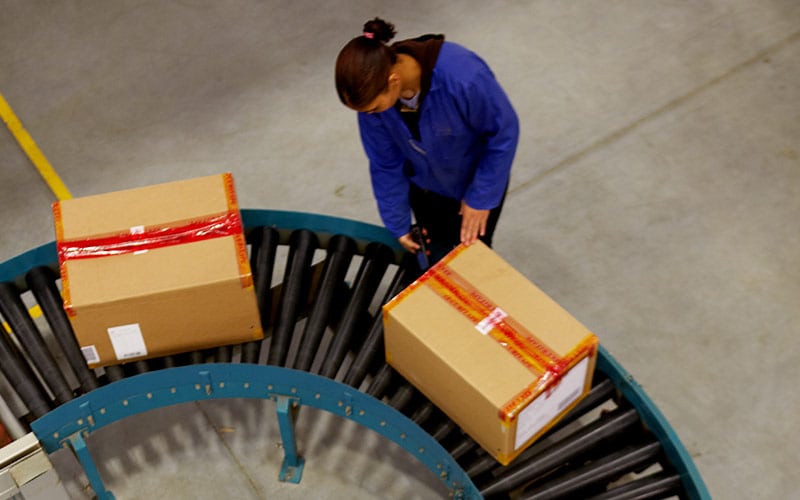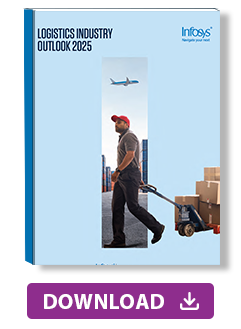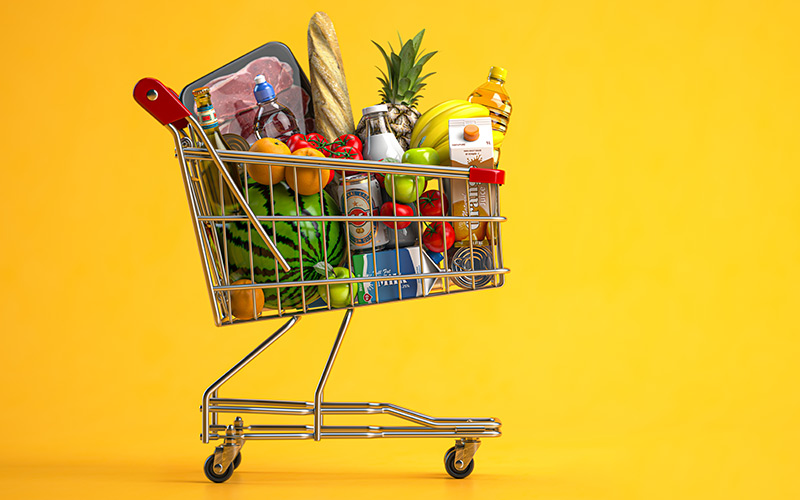Insights
- The logistics industry is expanding rapidly as online shopping fuels the need for faster and more secure deliveries.
- The rise of omnichannel retail has introduced new complexities, with consumers expecting flexible options like store pickup, home delivery from physical stores, and the ability to choose or change delivery preferences.
- Meeting these expectations requires tight integration between inventory control, warehousing, and fulfillment operations.
- To overcome challenges like increasing transportation costs, labor gaps, and supply chain disruptions, logistics providers are relying more on advanced technologies and smarter workforce strategies.
Executive summary

The logistics market is growing significantly. With the increase in online shopping, the need to safely and quickly deliver goods to the consumer has risen. Omnichannel retailing has created layers of complexity for the e-commerce world, where customers now have a range of options. These include buy online, pick up in store (BOPIS), paying for an item at a physical store and having it shipped home, choosing a convenient delivery slot, and changing the delivery location, among others. These options create a complex landscape, demanding close cooperation between inventory management, warehousing, and order fulfillment to work well.
Logistics companies are struggling with challenges such as rising transportation costs, labor shortages, supply chain disruptions, high delivery expectations, and efficient inventory management. Supply chain, logistics, and transportation companies are the largest users of logistics IT solutions, and making the best use of advanced logistics solutions and better workforce management could help them solve some of these problems.
Financial insights

The global logistics market size is predicted to touch $8.1 trillion by 2030, growing at a compound annual growth rate (CAGR) of almost 5% between 2025 and 2030. This growth can be attributed to factors such as expanding commerce, globalization of trade, increasing demand for faster delivery, and the use of AI technology.
International trade agreements have facilitated the swift movement of goods by easing border formalities. A recent example is the UK-India free trade agreement, which was finalized on May 6, 2025. This landmark deal eliminates tariffs on nearly 99% of Indian exports, opening greater access for industries such as textiles, engineering goods, and high-value services like information technology and finance.
In 2024, the Asia-Pacific region led the global logistics market, holding the largest share at 44.6%, driven by increased adoption of advanced technologies and favorable government policies that promote trade, and the region continues to do well in this. Europe followed as the second-largest market, but both regions will be outstripped by North America, which — in spite of having a market share of 22% in 2024 — is expected to lead the global logistics market from 2025 to 2034. North America’s surge is largely driven by growth in e-commerce – particularly in same-day delivery — which has created intense demand for high-efficiency warehousing, streamlined fulfillment, and advanced last-mile logistics, whereas Europe and Asia-Pacific have been slower to scale these capabilities.
The value of the e-commerce logistics market is expected to go above $535 billion this year. Rising fuel prices and a persistent shortage of drivers worldwide are driving up costs. The substantial impact of autonomous trucks on operational costs could help grow the market to approximately $600 billion by 2035. Meanwhile, other modes of transport are seeing growth: There is growing demand for waterway transportation, owing to its cost efficiency and higher cargo capacity. It was the fastest-growing segment last year. The global water transport market is projected to reach $983 billion by 2032, growing at a CAGR of 6.2% between 2024 and 2032. Similarly, growing demand for efficient freight solutions and increasing emphasis on sustainable practices are also boosting the rail logistics market, which is set to grow at a CAGR of 4.1%, reaching almost $507 billion by 2034 from $355 billion in 2025.
Marketing spending
Research has shown that logistics companies are investing in social media paid ads, search engine optimization, paid search marketing, video marketing, and web design and development, with lead generation their main goal.
Due to intense competition, companies also have to rely on these mediums to draw audiences. These platforms allow logistics companies to shape brand perception and present themselves as credible, forward-thinking partners to potential customers who engage with content on these channels. Social media also enables them to build relationships and craft targeted messaging that speaks directly to key decision-makers, industry partners, and influencers.
Industry dynamics
The shifting geopolitical landscape has been testing the logistics industry, with uncertainty over fast-moving US government-imposed tariffs posing particular concern. As a result of this uncertainty, global container volumes have dipped. Orders for consumer goods, industrial products and furniture — manufactured in factories in China and imported by global retailers to the US — have collapsed. Based on the percentage of tariffs applicable to them and the locations they operate in, brands will look at taking a step back from their usual logistics operations to explore new ways to reduce the impact of tariffs.
This could be in the form of looking at non-US markets; shifting manufacturing to the US to avoid import tariffs; sourcing from alternate locations and reducing reliance on low-margin products — such as fast-fashion garments, small auto parts, inexpensive electronics — that are affected by tariffs. Nearshoring is booming. FedEx shares fell 8% due to lesser B2B volumes. Demand for warehousing facilities is increasing with brands needing space to stock their products while they come up with contingency plans or shipping from domestic warehouses.
Logistics companies will have to find a way to adapt to the challenges surrounding them, be it rising operational costs, tariff regulations, or competition from peers. There’s a need for them to be agile and build more resilient supply chains to meet constantly changing needs and demands of their environment and to mitigate the risks caused by them. There is also a need to be able to forecast what’s coming in terms of demand, supply, or disruptions to movement, using the right technology.
Mergers and acquisitions
In 2024, the mergers and acquisitions (M&A) activity in the European logistics sector increased after a slump, growing from 257 deals in 2021 to 364 deals in 2024, to give rise to high-value deals. DSV acquired Schenker, and EP Group acquired International Distribution Services. Global M&A activity is expected to increase this year, highlighting ongoing industry consolidation. Some corporate-led deals made headlines: DP World acquired Edge Worldwide Logistics to fortify its freight forwarding and logistics capabilities, and JAS Worldwide acquired International Airfreight Associates. These acquisitions are helping the brands expand their global footprint, particularly across high-growth trade corridors and previously underserved regions. DSV’s acquisition is helping it double in size and get access to new markets.
After a volatile few pandemic years that saw supply chain shocks and inflation, logistics companies are consolidating to build scale, expand capabilities, and de-risk operations.
Talent management
Talent shortage is a looming issue in the logistics industry: according to a survey carried out in North America and Europe, some 76% of respondents are facing significant workforce shortages in their logistics and supply chain operations. Notably, 37% stated the shortage as being a major barrier to business growth. Areas impacted the most by labor shortages include transportation operations, warehouse operations, transportation planning, inventory and distribution planning, customer service, and demand planning.
A key factor driving labor shortages in logistics is an aging workforce. A large share of employees, particularly truck drivers, warehouse staff, and freight handlers, are approaching retirement, and the industry is struggling to attract younger talent. Many logistics roles, such as warehouse pickers and delivery drivers, are physically demanding, offer limited career progression, and lack appeal to new entrants. The combination of long hours, relatively low pay in some segments, and limited work-life balance contributes to high attrition rates. At the same time, the rapid growth of e-commerce has intensified pressure on logistics companies, making it difficult to scale labor capacity in line with surging order volumes.
To address labor shortages, companies can adopt workforce-focused strategies. Flexible scheduling and shift swapping, enabled through workforce management software, can help accommodate employee preferences and reduce burnout.
Within warehouses, automation technologies can be deployed to handle repetitive tasks like picking, sorting, and packing, increasing efficiency while easing labor demands. Additionally, AI-powered driver management systems can be used to monitor performance and safety, and incentivize efficiency.
Sustainability investment
According to the European Environment Agency, global logistics could be responsible for up to 40% of worldwide carbon emissions by 2050 if no effective action is taken. This alarming projection is intensifying the urgency to focus on sustainable logistics to reduce the environmental impact of transportation and warehousing operations. To align with the Paris Agreement targets, companies are required to reduce their carbon emissions by 55% by 2030, compared to 1990 levels.
Europe has ramped up green investments to strengthen the GDP of its transport and storage sector and meet its climate goals. Between 2020 and 2030, the EU has estimated an additional annual investment of $663 billion will be needed to meet its climate commitments. Still, the long-term costs of climate inaction far outweigh the investment required for a sustainable transition.
Logistics companies will need to look at measures such as route optimization, electric vehicles, sustainable packaging, better inventory management, and reverse logistics to up their sustainability game. Additionally, a consumer study found that 57% of respondents expressed strong interest in sustainable home delivery options, while 99% indicated a willingness to take further steps to minimize their environmental footprint. Being more sustainable can help logistics companies win customers who share the same values. However, despite growing interest in eco-friendly options, consumers are less willing to pay a premium for sustainable delivery. This suggests that logistics companies might not be able to pass additional costs on and will instead need to absorb the investments required to make their operations more sustainable.
Trends
Cost-efficient last-mile delivery
Last-mile delivery innovations secured the seventh spot in a list of the top 15 industry trends, according to a Maersk survey of decision-makers. The global last-mile delivery market was valued at close to $147 billion in 2023 and is projected to grow at a CAGR of 9.8% from 2024 to 2032, to around $310 billion. The rising demand for speed in last-mile delivery is a contributing factor. Two-thirds of consumers globally expect to receive their deliveries within 24 hours. With last-mile deliveries amounting to almost 53% of total shipping costs in business-to-consumer supply chains, logistics companies are trying to optimize costs. The answer lies in streamlining their operations by using technology to gain end-to-end supply chain visibility, predict demand, automate warehouses, optimize routes, and manage fleets.
Trends emerging in the US indicate a shift in consumer preferences beyond just speed and towards flexibility related to returns. Consumers might be open to accepting slightly slower delivery speeds in exchange for greater reliability and confidence that their packages will reach them within the stated delivery window. This emphasizes the need for an overall positive delivery experience which includes consolidated shipments, choice of delivery location, and environmentally sustainable delivery options through collaborative logistics.
End-to-end resilience
With disruptions stemming from geopolitical tensions, cyberattacks, labor strikes, or natural disasters becoming more frequent, severe, and hard to predict, global supply chains are increasingly recognizing that the only way to keep delivering on customer promises without interruption is by strengthening their end-to-end resilience. This means ensuring that every aspect of the supply chain — from sourcing raw materials and transporting them, to manufacturing, storage, and final delivery via multimodal transport — is sufficiently agile, robust, adaptable, and well-prepared to keep operations running smoothly, even in the face of external shocks and uncertainty. Adapting to challenges in the logistics industry will require end-to-end visibility of operations, the ability to pull out quick insights about any link in the chain, and the capacity to make quick adjustments in the movement of goods and materials or raw material sources.
The shift to sustainability
Logistics companies are turning to more sustainable practices such as cutting the distance goods are transported, to reduce emissions, using alternative fuels, optimizing delivery routes, and are looking to make their operations more energy efficient, with the aim of cutting costs, meeting sustainability targets, and boosting their brand reputation. What’s more, research shows that 73% of customers would be happy to receive a package a day later if it reduces the environmental impact.
Hyperlocal logistics
Another medium that logistics companies are turning to reduce costs and keep customers happy with quick deliveries is hyperlocal logistics. Hyperlocal delivery involves delivering products quickly within a limited geographic area such as a city or neighborhood, and caters to customers who are located in that area.
Valued at $1.5 trillion in 2021, the global hyperlocal services market is projected to reach $5.9 trillion by 2031, growing at a CAGR of 14.4% between 2022 and 2031. Ikea is one of the first few companies that has invested in a logistics platform that enables last-mile deliveries across Europe from hyperlocal hubs. Amazon, Target with its acquisition of Shipt, and Walmart GoLocal are other brands that prominently use hyperlocal delivery.
Technology outlook
According to research, the top five logistics and supply chain tech solutions offered are AI, followed by optimization, data management and analytics, process improvement solutions, and transportation management systems. This reflects a growing focus on technologies that drive greater efficiency, visibility, and agility across operations.
Artificial intelligence
Valued at $26.3 billion in 2025, the global artificial intelligence (AI) in logistics market size is projected to grow to nearly $708 billion by 2034, reflecting a CAGR of 44% during the forecast period. Advancements in the logistics sector around the world are fueling this growth. While North America has led the AI in logistics market for a while, APAC is all set to be the fastest-growing region during the forecast period, thanks to rising interest and investment in AI research and development by both public and private sectors. Early adopters who successfully implemented AI-enabled supply chain management have reduced logistics costs by 15%, lowered inventory levels by 35%, and improved service levels by 65% — outperforming their slower-moving competitors.
However, as per Infosys research, almost 19% of logistics and supply chain companies surveyed haven’t embarked on any generative AI initiatives (Figure 1).
Figure 1. AI adoption is cautious in logistics companies
Source: Infosys Knowledge Institute
The good news is that 25% of respondents from the Infosys survey believe that generative AI will have a positive impact on operational efficiency and automation (Figure 2). To maximize AI’s impact, logistics companies should first evaluate their data readiness in terms of storage, sources, and quality; set up a governance task force to oversee data integrity, compliance, and responsible AI use; train and upskill employees to work effectively with AI technologies from route optimization to telematics, and consider hiring additional expertise if needed, and involve employees in decision-making to boost implementation success. They should also invest in a unified last-mile delivery platform to streamline operations and enable contextual, data-informed decisions.
Figure 2. Positive impact expected in user experience and personalization
Source: Infosys Knowledge Institute
Case studies
Infosys Consulting supported a Fortune 50 global logistics company in shifting to being a data-centric organization by developing a platform to use AI and machine learning models to improve delivery-date predictions. Joseph Rajadurai, managing partner, consumer goods, retail and logistics at Infosys Consulting adds: “A new architecture was implemented to enable higher throughput with lower latency, reducing delivery prediction latency from between 15 minutes to 17 minutes down to an average of one minute, with 99% processed within two minutes.”
Another example of the successful use of AI in logistics is that of CMA CGM Air Cargo optimizing its load planning and enhancing operational safety across its network by implementing Champ’s AI-enabled weight and balance solution. This uses algorithms and AI to generate a load plan quickly, cutting down manual processing and increasing flight safety and fuel efficiency.
Agentic AI, an AI system designed to achieve a specific objective with minimal human oversight, is also helping logistics companies solve challenges related to route optimization. UPS’s Orion is an AI agent that autonomously optimizes delivery routes by analyzing historical and real-time data, from traffic patterns and weather forecasts. Using this led to $300 million in annual savings for the company.
Meanwhile, Amazon is deploying an agentic AI team within Amazon Robotics which is developing an AI framework designed to enable robots to hear, comprehend natural language, reason, and take independent action in its fulfillment centers.
Automation
In 2024, the global logistics automation market was valued at $78 billion. It’s expected to grow to $88 billion in 2025 and then to almost $213 billion by 2032, at a CAGR of 13.4%.
Logistics automation refers to using technology to automate routine tasks, helping companies increase efficiency, minimize errors, and reduce costs in areas such as transportation, inventory management, and warehousing. Some 64% of companies are making new investments into automation and technology, as per a survey. The number of companies planning to evaluate autonomous mobile robots and automatic guided vehicles as options in their operations has increased from 20% in 2023 to 30% in 2025. While trucks that lift packages and rack them on shelves remain a constant area of spending, using automated data analytics for performance tracking is also generating interest.
Autonomous vehicles
The use of drones and autonomous vehicles is offering logistics companies a way forward, helping reduce expenses, increase delivery speed and reliability, and improve overall operational efficiency — while delivering additional benefits like greater safety, real-time visibility, and enhanced accessibility.
Autonomous vehicles are being used for everything from long hauls to last-mile delivery and warehouse fulfillment for inventory scanning, picking and packing, and so on. Aurrigo International has introduced Auto-Cargo, its largest aviation vehicle yet. This advanced airside logistics vehicle can autonomously move up to 16,500 kg of cargo, powered by an electric, zero-emission platform. It incorporates precision automation, advanced obstacle detection, and real-time fleet coordination, reducing the pressure on ground crews, strengthening safety, and streamlining operations. Domino’s Pizza has launched autonomous vehicle delivery in Houston, partnering with Nuro, a robotics company specializing in self-driving, electric delivery vehicles.
Drones
Drones are being used to deliver small packages, warehouse surveillance, and scanning services in warehouses. Drones and AVs use a combination of technologies such as AI/ML, Light Detection and Ranging (Lidar) and sensors, GPS, cloud computing, and 5G to function. As drones use battery power, they can be a sustainable option for logistics companies to operate in areas with limited road connectivity, or too much traffic. Zipline, a leading autonomous delivery drone startup, has completed 1 million deliveries to customers, with its zero-emission drones covering more than 70 million commercial autonomous miles across four continents. Deliveroo has partnered with Manna to launched drone deliveries in Dublin. Currently in test phase, this initiative enables quick, electric-powered delivery of food and essentials, to support Deliveroo’s push for more sustainable last-mile solutions while enhancing customer convenience in suburban areas.
Precision analytics
Logistics depends on data, which means that predictive analytics can help logistics companies predict demand and act accordingly to mitigate risks. It can help them in dynamic pricing, scenario planning, and inventory management to prevent overstocking or understocking. It can also enhance fleet operations by optimizing routes and vehicle use. It also helps in predictive maintenance to repair machinery that’s due for servicing or on the verge of breakdown.
However, while predictive analytics in logistics offers significant benefits, companies must be mindful of implementation challenges — from keeping data accurate and up to date, to managing its volume and complexity, and strengthening data security and privacy to guard against vulnerabilities.
Key takeaways
- The logistics market is experiencing strong growth due to a surge in online shopping and growing delivery demands. This expansion brings additional complexity, with companies needing to manage a range of delivery options, inventories, and customer preferences. Successful companies will be those that can efficiently balance these competing priorities while delivering a smooth customer experience.
- Higher transportation costs, labor shortages, and disrupted supply chains are adding pressure to the industry. Rising delivery expectations further raise the bar for companies to perform efficiently and cost-effectively. Implementing advanced technologies and optimizing workforce management can aid companies in navigating these pressures.
M&A activity in the logistics sector is on the rise, with companies strengthening their portfolios through strategic transactions. Companies are looking for scale, synergy, and a competitive edge in a challenging market. - Sustainability is a key consideration for companies as they work toward reducing emissions and their carbon footprint. Rising consumer awareness — alongside regulations — is adding pressure to implement eco-friendly practices. Sustainable packaging, route optimization, electric vehicles, and reverse logistics can enable companies to align with climate goals while strengthening loyalty among their customers.
- Automation and robotics are enabling companies to handle routines efficiently while reducing human error and operational costs. Drones and autonomous vehicles are aiding in delivering small packages and navigating hard-to-reach or congested areas. Precise data and predictive analytics in logistics further empower companies to make smarter decisions, optimizing delivery, pricing, inventory, and maintenance schedules.
- AI is poised to transform logistics operations by optimizing routes, reducing inventory, and improving delivery estimates. The market for AI in logistics is expected to grow from $26.3 billion in 2025 to nearly $708 billion by 2034 — reflecting a CAGR of 44%. Successful companies will align their data readiness, training, and governance to maximize the value that AI brings.








